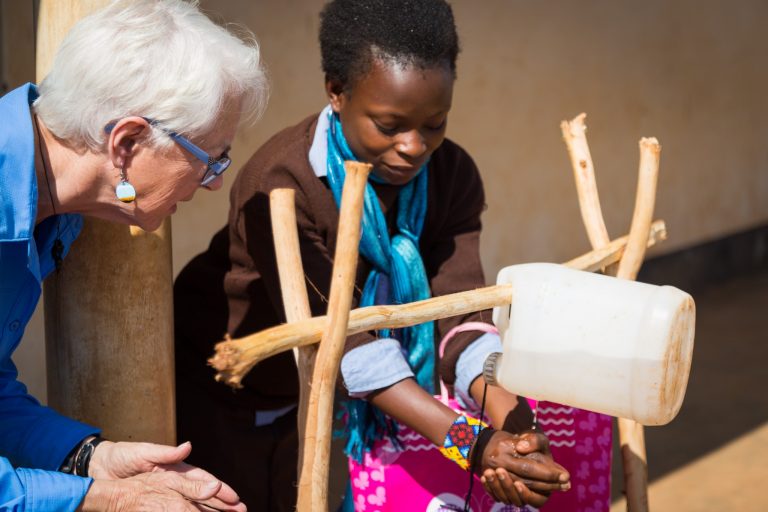In 1846 Dr. Ignal Semmelweis discovered that the absence of health provider handwashing practices prior to delivery increased the maternal mortality rate in his maternity clinic by 5 times when compared to deliveries where providers washed their hands before delivery. The interesting story surrounding his discovery and the subsequent refusal by clinic staff to adopt clean birth hygiene practices was featured in an NPR news segment in 2015.
Although our knowledge around infections and infection prevention has evolved substantially since Dr. Semmelweis’s time, maternal and newborn survival remains a significant global challenge. Worldwide, sepsis infections alone account for 11% of maternal deaths[1] and 7% of neonatal deaths[2] annually. Hygiene is a critical, low cost solution for preventing maternal and newborn infection.
A 2008 study conducted in Nepal by Victor Rhee and colleagues demonstrated that newborns had a 60% lower risk of death when mothers reported washing their hands before handling the baby sometimes or always.[3]
Similarly, birth attendant hand washing resulted in a 25% lower risk of neonatal death when compared with neonates whose birth attendant did not wash hands. The study suggests that handwashing reduces newborn exposure to infectious pathogens, thereby reducing mortality due to neonatal infection.
As we celebrate Global Handwashing Day, the Healthy Newborn Network (HNN) is sharing recent research, success stories, and resources that demonstrate how handwashing and other hygiene practices can save lives. Please explore these resources and spread the word on the importance of handwashing!
Follow @HealthyNewborns and join the conversation on Twitter using #GlobalHandwashingDay.
Resources
- The Doctor Who Championed Hand-Washing and Briefly Saved Lives
The sad but true story of Dr. Ignal Semmelweis’s discovery of the importance of handwashing and his failed efforts to convince his colleagues. NPR. - The 10 Point History Lesson of Poor Handwashing: Compelling Lessons Continue with Little Effect on Handwashing Compliance
This interesting graphic by the Handwashing For Life Institute provides a timeline of historical events tied to handwashing (or the absence of handwashing). - Facts and Figures: Water, sanitation and hygiene and maternal and newborn health
This report by Evidence Action provides an overview of how water, sanitation and hygiene conditions and practices are linked to maternal and newborn health. - Association between water and sanitation environment and maternal mortality: A systematic review and meta-analysis
This systematic review shows that poor Water, Sanitation & Hygiene (WASH) conditions are associated with higher maternal mortality. - Maternal and Birth Attendant Hand Washing and Neonatal Mortality in Southern Nepal
This 2008 study conducted in Nepal demonstrated that birth attendant hand washing resulted in a 25% lower risk of death compared with those who did not wash hands. Similarly, newborns had a 60% lower risk of death when mothers reported washing their hands before handling the baby sometimes or always. The study suggests that hand washing reduces overall newborn exposure to life-threatening pathogens, thus reducing mortality due to infection. - Hand hygiene: simple and complex
Though the act of handwashing is simple, many social, economic and environmental barriers results in low compliance with handwashing worldwide. This review provides a brief history of handwashing and discusses the complexities involved in convincing people to comply with handwashing at important times. - Clean Birth Kits – Potential to Deliver? Evidence, Experience, Estimated Lives Saved and Cost
This report provides a clear framework on how 6 clean practices can ensure a clean birthing experience for mothers and newborns. - The Clean Household Approach
This 2-page brief outlines Save the Children’s “Clean Household Approach” to ensuring a clean home environment. Although this document primarily focuses on water, sanitation and hygiene contributions to child nutrition, the outlined behaviors can serve as a basic cleanliness standard for any household. - The Science of Habit: Creating Disruptive and Sticky Behavior Change in Handwashing Behavior
Dr. David Neal, from Catalyst Behavioral Sciences, published this paper exploring how the science of habit can be used to drive handwashing behaviors. Based on his work in conjunction with USAID/WASHplus project, this brief describes six practical ways in which habits can be leveraged for hygiene behavior change and integrated into handwashing programs. You can learn more about this concept in a webinar co-hosted by USAID WASHplus and the PPPHW detailing how habit theory can be harnessed to advance handwashing behavior, and a presentation delivered at the 2014 UNC Water & Health Conference illustrating how the habit-formation approach can help foster and encourage healthy habits through developing strategies in a way that allows handwashing behavior to be easily adopted. - Healthy Start: the first month of life
This report reveals the devastating impact of a lack of safe water and sanitation on newborns in developing countries. It also highlights the risks presented by healthcare facilities that do not offer a hygienic birth environment.
[1] Say, Lale et al. Global causes of maternal death: a WHO systematic analysis. The Lancet Global Health , Volume 2 , Issue 6 , e323 – e333
[2] WHO (2015). World Health Statistics 2015. World Health Organization
[3] Rhee V. et al. 2008. “Maternal and Birth Attendant Hand Washing and Neonatal Mortality in Southern Nepal.” Archives of Pediatrics & Adolescent Medicine. Vol. 162 (No. 7), pp 603-608. July 2008.
